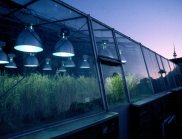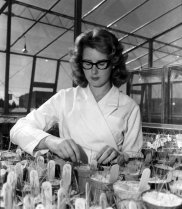CSIRO’s other icon celebrates 50 years
The heritage-listed building will celebrate 50 years of globally significant plant research this week when Australia’s Chief Scientist, Prof Ian Chubb, opens the newly-refurbished Phytotron facility at Black Mountain as part of the Centenary of Canberra celebrations.
The Phytotron, designed by renowned Australian architect Roy Grounds, has long been an incubator for world-leading research by CSIRO plant scientists.
“The refurbishment of this building enables the Phytotron to continue to produce great science and act as a melting pot for the world’s leading plant scientists to tackle pressing global issues.”
Dr John Manners, Chief, CSIRO Plant Industry
Pioneering work carried out there in the 1970s helped explain how plants react to environmental factors such as temperature, light intensity and daylength – critical information for improving crop productivity. It has played a major role in Australian plant research and has evolved with the times to remain an important facility in the current era of genomics and phenomics research.
Constructed around the same time as the Parkes Radio Telescope, the Phytotron was another ambitious CSIRO infrastructure project, which has gone on to make a lasting contribution to the Australian community.
Prime Minister Robert Menzies observed when he opened the Phytotron on August 29, 1962: “This field of scientific endeavour [plant science] is one of the great hopes of the future of mankind – one of the great hopes for future peace – for in a starving world, there will always be war”.
The Chief of CSIRO Plant Industry, Dr John Manners, said the 50th anniversary of the Phytotron marked an important day for Canberra, as well as for Australian science.
“The refurbishment of this building enables the Phytotron to continue to produce great science and act as a melting pot for the world’s leading plant scientists to tackle pressing global issues,” Dr Manners said.
Prof Chubb will open the refurbished Phytotron at CSIRO’s Black Mountain Laboratories at a ceremony on Thursday, 18 April, as part of the Phytotron 50th Jubilee celebrations.
For more details about the Phytotron Jubilee event, including speaker bios, see: Phytotron
Media resources
Click image for high resolution version



